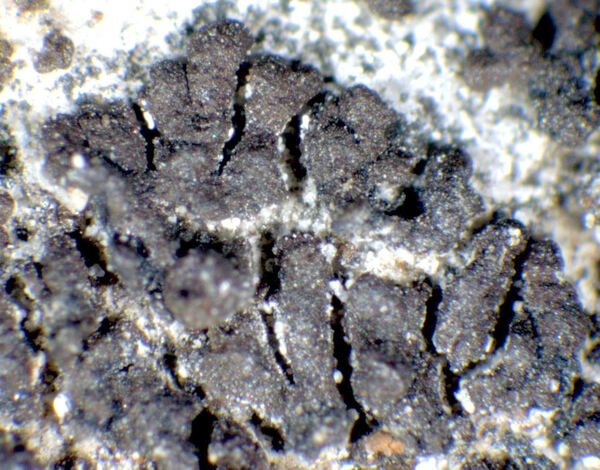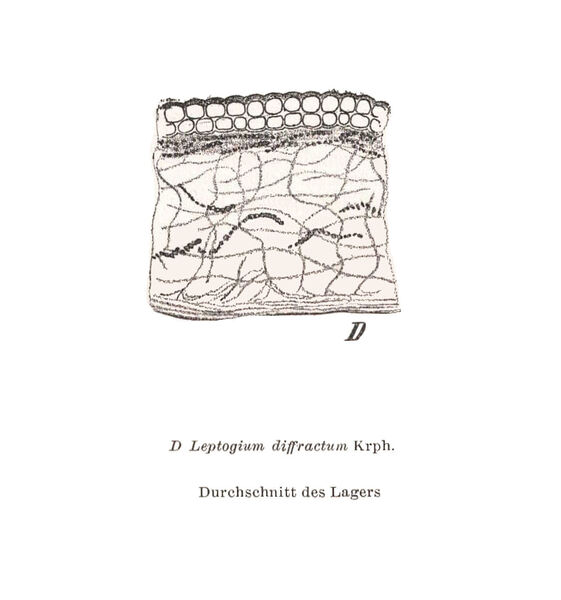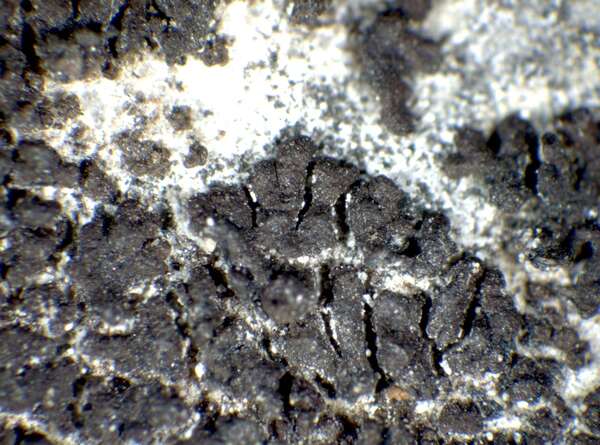Pseudoleptogium diffractum (Körb.) Müll. Arg.
Flora, 68: 516, 1885. Basionym: Leptogium diffractum Kremp. ex Körb. - Parerga Lichenol.: 424, 1865.
Synonyms: Leptogium placodiellum Nyl.
Description: Thallus crustose-placodioid to subsquamulose-placodioid, gelatinous when wet, forming 0.5-1 cm wide rosettes, sometimes more thalli coalescing into larger patches, the marginal lobes radiating, 0.4-1.3 mm long, 0.2-0.5 mm wide, flat to convex, contiguous for most of their length, often wrinkled and glossy at lobe ends, dark olive brown to black; center of thallus with convex 0.1-0.2(-0.3) mm wide areoles or granules, often dying off to leave semicircular areas of lobes. Thallus anatomy paraplectenchymatous, of short-celled, compact hyphae, with a distinct cortex of smaller cells. Apothecia very rare, 0.2-0.5 mm across, with an olivaceous brown disc and a thin thalline margin. Epithecium brownish; hymenium and hypothecium colourless; paraphyses coherent, mostly simple, the apical cells slightly swollen. Asci 8-spored, cylindrical-clavate, the apex strongly thickened, the apical dome K/I+ pale blue, with a downwardly projecting K/I+ deep blue tubular structure. Ascospores submuriform, hyaline, ellipsoid (15-)22-25(-30) x 8-10(-12) μm. Photobiont cyanobacterial (Nostoc, the individual cells 4-6 µm wide, arranged in clusters). Spot tests: all negative. Chemistry: without lichen substances.
Growth form: Crustose placodiomorph
Substrata: rocks
Photobiont: cyanobacteria, filamentous (e.g. Nostoc, Scytonema)
Reproductive strategy: mainly sexual
On otherwise dry surfaces with short periods of water seepage after rain
Commonnes-rarity: (info)
Alpine belt: absent
Subalpine belt: absent
Montane belt: very rare
Dry submediterranean belt: rare
Humid submediterranean belt: rather rare
Padanian area: absent
pH of the substrata:
1 2 3 4 5
Solar irradiation:
1 2 3 4 5
Aridity:
1 2 3 4 5
Eutrophication:
1 2 3 4 5
Poleotolerance:
0 1 2 3
Altitudinal distribution:
1 2 3 4 5 6
Rarity
absent
extremely rare
very rare
rare
rather rare
rather common
common
very common
extremely common
Loading data...
Occurrence data
Predictive map
Growth form: Crustose placodiomorph
Substrata: rocks
Photobiont: cyanobacteria, filamentous (e.g. Nostoc, Scytonema)
Reproductive strategy: mainly sexual
On otherwise dry surfaces with short periods of water seepage after rain
Commonnes-rarity: (info)
Alpine belt: absent
Subalpine belt: absent
Montane belt: very rare
Dry submediterranean belt: rare
Humid submediterranean belt: rather rare
Padanian area: absent
pH of the substrata:
| 1 | 2 | 3 | 4 | 5 |
Solar irradiation:
| 1 | 2 | 3 | 4 | 5 |
Aridity:
| 1 | 2 | 3 | 4 | 5 |
Eutrophication:
| 1 | 2 | 3 | 4 | 5 |
Poleotolerance:
| 0 | 1 | 2 | 3 |
Altitudinal distribution:
| 1 | 2 | 3 | 4 | 5 | 6 |
Rarity
absent
extremely rare
very rare
rare
rather rare
rather common
common
very common
extremely common
Loading data...
Occurrence data
Predictive map









